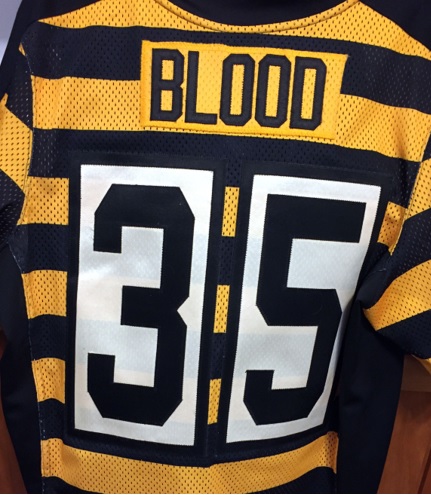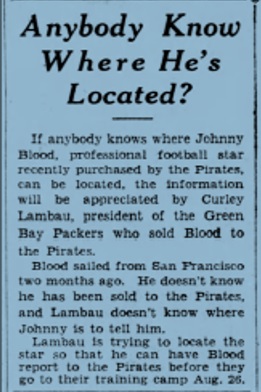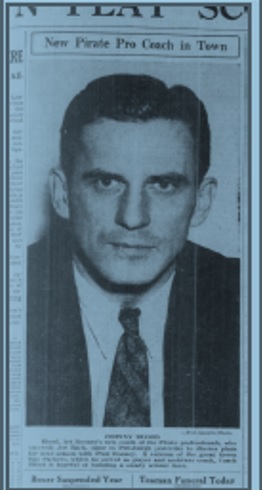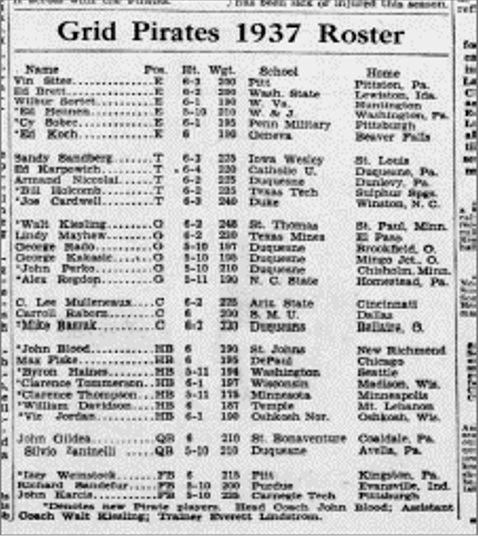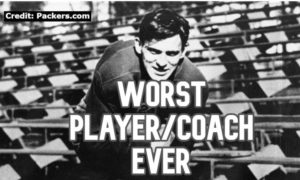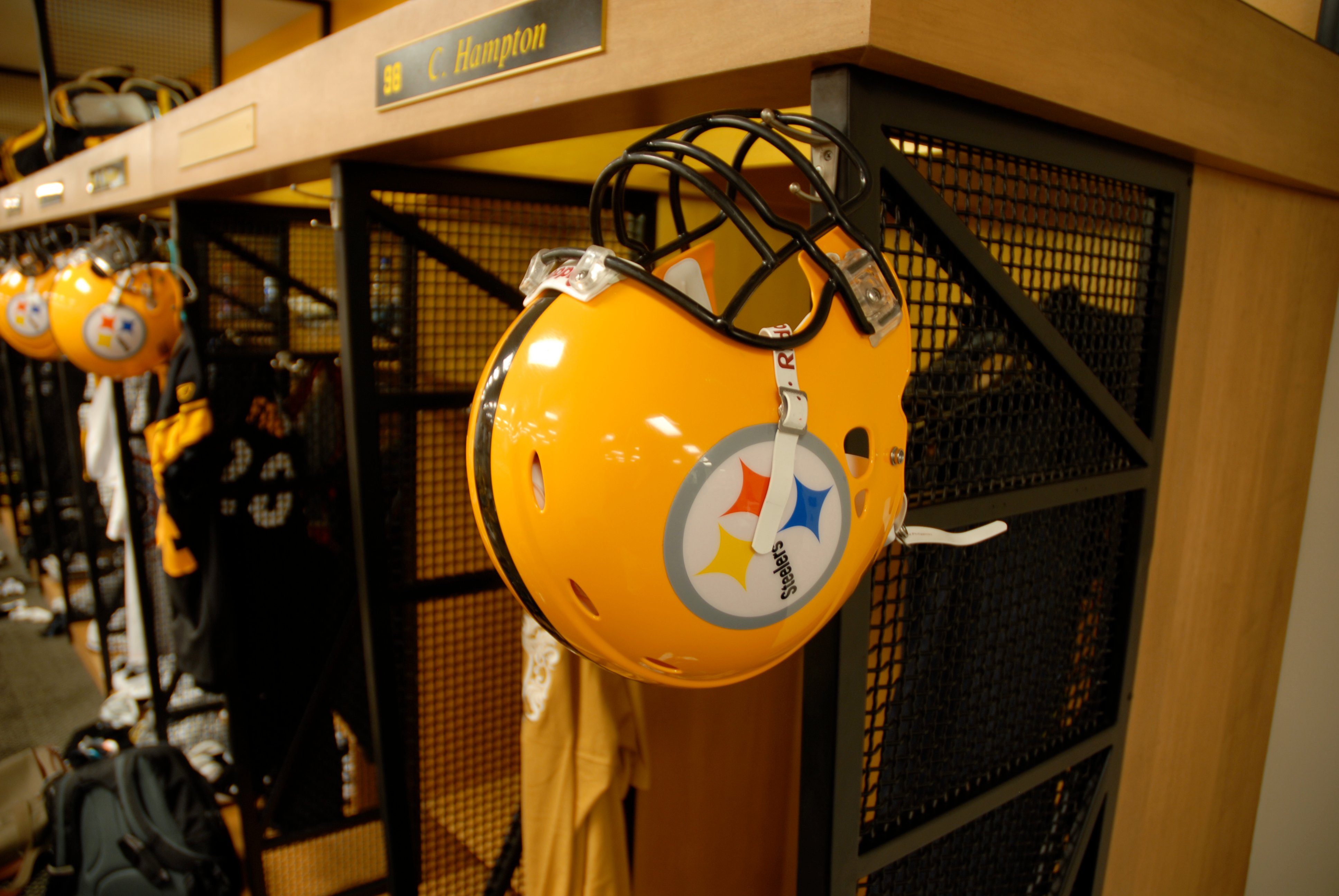THE HIGHER PASTIME
This article is a continuation of a series about the Pittsburgh Steelers coaches that preceded Chuck Noll, Bill Cowher, and Mike Tomlin. I read several scores of newspaper articles from the Pittsburgh Post-Gazette, Pittsburgh Press & Pittsburgh Courier. Pro Football Reference used as a reference for the statistical data. I’ve interjected my own opinion but quoted articles directly, so you can get a sense of what Pittsburgh football fans were reading at the time.
College football considered the higher pastime than professional football. The NFL consisted of just nine franchises in 1936, down from a peak of 22 teams in 1926. A tenth team added in 1937. The Cleveland Rams who are now back in Los Angeles.
Various college all-star teams would play the professionals but the big one was at Chicago. The games were very competitive and would attract large crowds. The September 1, 1937 game between the College All-Stars and the Green Bay Packers had 84,560 fans watching the “rah rah kids” defeat the “paid-to-play” men 6-0.
JOHNNY BLOOD
As for the Pittsburgh Football Pirates (Steelers); their 1936 season had left them on the brink of playing in the NFL championship. Win the last game of the season and they would host the championship. Sadly, it was not to be. Coach Joe Bach also decided to return to the college coaching ranks leaving Pittsburgh behind for Niagara University. Team president and owner, Art Rooney had to find his fourth head coach in the team’s fifth season of existence.
A January 14, 1937 Post-Gazette article reported Rooney had already picked Johnny “Blood” McNally to coach if Bach resigned to go with the rah-rah boys. “He (Rooney) has a deep personal conviction that Johnny Blood, one-time Notre Dame player (he never played a game there); is the ideal man. He has no assurances that he would take the job.”
BLOOD WOULD-BE OWNER
The writer of that article had good information. It was announced on February 3 that Rooney was offering Johnny Blood the job since Bach decided to leave Pittsburgh for Niagara. The potential deal breaker was Blood’s applying for a Minnesota franchise to enter the National Football league. He would be owner/coach and probably a player to if the NFL accepted the application.
Blood’s entry was one of three potential franchises the NFL considered adding as a tenth team. The front runner was the Los Angeles Bulldogs on probationary status in 1936. The Bulldogs went 3-2-1 (6-3-1 overall) against NFL teams including beating Pittsburgh. However, the Cleveland Rams, runners up of the American Football League, now ironically back in Los Angeles, was awarded the franchise. This of course freed up Johnny Blood who accepted his contract around February 20.
VAGABOND HALFBACK
Art Rooney hired former college stars as his first three selections: We have already written about Jap Douds of Washington & Jefferson; Luby DiMeollo of Pitt and Joe Bach of Notre Dame. This time, the Prez selected a coach who was more known for his play in the NFL than in college. Johnny Blood played some college football at Saint John’s University in Minnesota. He transferred to Notre Dame but was suspended from the team for some debauchery and never did play for the Irish.
Johnny Blood is most famously known for his antics including using a pseudonym. One of the anecdotes is that in 1922; Blood and a buddy decided to try out for a semi-pro football team. To protect his college eligibility, he decided to use a fake name. On the way to sign-up they drove by a movie theater that was featuring the film Blood and Sand starring Rudolph Valentino. He decided to adopt the name Blood and christened his buddy Sand.
But the “Vagabond Halfback” compensated for his extracurricular activities with outstanding feats on the playing field. The earliest record of Blood playing in the NFL was with the Milwaukee Badgers in 1925. He shifted to the Duluth Eskimos for two season and even played for the Pottsville Maroons with another future Steelers coach Walt Kiesling before finding his longest home in Green Bay with the Packers. He played seven seasons for Green Bay including four NFL championship seasons. His most prolific season was 1931 when he had 13 touchdowns – 11 receptions, two rushing and even chipped in a pick-six. He led the league with 78 points. That was 29% of Green Bay’s scoring that year leading them to a 12-2 record and their third consecutive championship.
THE ORIGINAL IRON-MAN
I read one article that claimed Johnny Blood had the all-time reception yardage record of 2755 yards until it was broken by until Don Hutson of the Green Bay Packers who surpassed it in November 1939. Unfortunately, the statistics kept by the Pro Football Reference only begin recording receiving yards in 1932 with Blood’s career already at the halfway point. What the articles do confirm is that Blood was a running, passing and receiving threat who also had a good foot for kicking which was used to gain territorial advantage much more than today’s game. He is also credited with five pick-sixes, a punt and a kickoff return for touchdowns.
By the time he retired from playing he was the original iron-man with a then record 14 seasons played. Walt Kiesling, his teammate and coaching partner was number two all-time with 13 seasons played. That record held until Mel Hein of the New York Giants played his fifteenth season in 1945. Blood is an inaugural member of the NFL Hall of Fame elected in 1963 and an inaugural member of the Green Bay Packer Hall of Fame. Some articles mention the possibility that he played for the Minneapolis Marines which would give him a 15 seasons played but I was unable to substantiate those claims.
In what could be a good line from Antonio Brown, Johnny Blood said way back in the day, “They pay me to score touchdowns. The swagger I give ‘em for free.”
LOST AT SEA
Johnny Blood already had played in Pittsburgh. Art Rooney certainly knew of his pedigree. Even prior to the Black and Gold’s first ever game – Pittsburgh Press sports editor Chester L. Smith mentioned that Burghers “ought to jump at the chance to watch … Johnny Blood” among other pros in an April 14, 1933 column. By July 1934 local papers reported that, “Art Rooney, president of the Pirate footballers, is angling for Johnny Blood, Green Bay’s great back.”
When Rooney signed Blood on August 1, the paper said that he was “rated one of the best field generals in he league. He is particularly adept at handling the ball, in kicking, passing, and receiving passes. His presence especially desired a tried general back of the line to direct the operation of the team afield.” In those days, many of the plays were called on the field of play by the players. Players tended to play both ways and it was not unusual for a player to play all 60 minutes in offense, defense and special teams. The coach’s role was often limited to player substitutions and giving advice after scores or game breaks at the quarter or half.
SOMEWHERE IN THE PACIFIC OCEAN
By August 17, the question the local papers were asking: where is the vagabond halfback? Art Rooney had contracted for the right to sign Blood on August 1, but that agreement was with Curly Lambeau, owner of the Packers. Back in these early days, the right to sign players to a contract belonged to the club owners. Once his rights were transferred, a player’s only choices were to negotiate a contract with the new team or quit playing.
Lambeau was unable to notify Blood that he his rights had been transferred to Pittsburgh because he could not be found to tell. On August 22, papers reported that Blood had been located working as a purser on an ocean liner “somewhere between the Philippines and San Francisco.”
Blood did arrive in Pittsburgh around August 26 to begin preparing for the first game scheduled for September 9, 1934. Luby DiMeollo planned to start Blood at quarterback – in the single wing this was more of a running and blocking position. The quarterback would also bark the signals. Halfbacks tended to pass more in this scheme.
FALSE START
Unfortunately, Rooney’s plans to have a new box office star on the fields fizzled. After reportedly hard workouts, Blood wrenched his leg or had a hernia operation, depending on the newspaper you read. He was hospitalized somewhere between September 2-5 for several weeks. Warren Heller moved over from halfback to take over Blood’s duties. Blood appeared in only five games.
Despite the lackluster season, Blood must have impressed Art Rooney. He was one of three candidates to coach the team in 1935 along with Red Grange and Joe Bach (who was selected once he resigned as head coach of Duquesne University).
In mid-August 1935 Johnny Blood advised the team that he would remain in Green Bay. He was recovering from his injuries from the 1934 season and he may have been disappointed that he was passed over as coach. In any case, he must have left in Rooney’s good graces, as Rooney agreed to turn Blood’s contract rights back over to Green Bay, “since Johnny wanted to play closer to home.”
BACK IN GREEN BAY
Johnny Blood started for Green bay in a 27-0 win over Pittsburgh on October 6, 1935 but then a couple weeks later suffered a “slight brain concussion” with attending physicians saying he had “a hemorrhage and blood clot on the brain. If Blood did not suffer a ruptured blood vessel he will recover ….” Apparently, he recovered as although he did not start in a November 24 rematch with Pittsburgh, he scored two touchdowns. A 41-yard pass reception that put Green Bay up 20-7, then returned an interception 11 yards for a touchdown and a final score of 34-14. But there must have been a tie to Pittsburgh. Johnny Blood came back to play for Pittsburgh in a charity game against local college all-stars that December.
Blood’s final season with the Packers was a passing of the guard. Don Hutson had become the receiving ace; although Blood had a 52-yard reception in the championship game against the Boston Redskins. He also had a good game against Pittsburgh in the regular season, intercepting another pass and returning it 58 yards for a touchdown; throwing a seven-yard touchdown pass and chipping in an extra point by running it in for a 42-10 victory. He had Pittsburgh’s number.
FOURTH STEELERS COACH
By mid-December 1936, it was reported that Johnny Blood was back in Pittsburgh to visit “for a few weeks.” There were already rumors that Joe Bach wanted to go back to coaching college football. The Chief must have had the 1930’s version of speed dial. Exit Joe Bach; enter Johnny “Blood” McNally as the fourth head coach of Pittsburgh’s NFL franchise.
In June 1937 Blood brought in former teammate Walt Kiesling to be assistant coach. Both planned to play as well as coach during the season. He planned to install the “Green Bay offense.” Not sure how this differed from other teams but that is a story for another day. Pittsburgh’s fifth training camp was scheduled to begin August 8, 1937 giving the team four weeks to prepare for their opening game scheduled for September 5.
The NFL limited the in-season roster size to 25 players for 1937. Blood brought in 30 players plus himself and Kiesling for training camp – one-third of today’s preseason rosters. Here is what is initial preseason roster looked like that included five of the 19 players Pittsburgh drafted in 1936 and 37:
PLAYER OR COACH?
Sixteen new players were on the roster from the 6-6 1936 team. Duquesne center Mike Basrak was the big-name rookie and became a first team all-pro his first year. The season opened against the Philadelphia Eagles and hyped Pittsburgh fans. After the Eagles tied the score 14-14 in the fourth quarter; Johnny Blood returned the kickoff 92-yards for a touchdown and a 21-14 lead. He added a 44 yard reception off a Max Fiske pass to make the final 28-14.
Blood would catch another Fiske pass for a touchdown in a 21-0 victory over the Brooklyn Dodgers. A record crowd of 33,095 at Forbes Field witnessed a tight game going into the fourth quarter only to be disappointed by a field goal that gave the New York Giants a 10-7 win.
Claire Burcky of the Pittsburgh Press blamed the loss on turnover: The Giants recovered five of nine Pittsburgh fumbles and had five interceptions. The defense remarkably held the Giants to 10 points. Burcky added blame for the loss with the coach. “Johnny Blood, it was apparent to many critics, tried to do too much. He played almost the entire game at right and left halfbacks, quarterback and end. Granting he is a smart coach and a polished performer, he might have obtained better results sizing up the picture from the sidelines occasionally.”
CHEERED THEN BOOED
More heartbreaking losses followed. Bronko Nagurski and the Bears win 7-0 with a third quarter touchdown. Detroit Lions came from behind to win 7-3. The Redskins were down 13-0 (almost 20 but officials nullified a score) at the half but come back to win 34-20. Blood played extensively scoring twice including a 43-yard pass from Fiske. A 13-7 loss to the Chicago Cardinals with fans booing Blood and injuring his shoulder near the end of the game. Bill Davidson had the only Pittsburgh score on a 65-yard passing play from Fiske.
Blood said after the Cardinal game, “They cheered me a couple weeks ago. Now they boo me. Well, it’s all in the game.” Under 10,000 fans attended Pittsburgh home games after five straight losses when the Pirates (Steelers) were tied or leading each game at the half. They finally broke the losing streak in front of less than 3,000 fans at Forbes Field – less than a tenth of the attendance earlier against the Giants. Bill Davidson’s 87-yard interception return the big play in a 16-7 victory.
A SPARK THEN FIZZLE
A 17-0 loss to the Giants in New York followed. But Pittsburgh still had some spark. They defeated the now Washington Redskins featuring ‘Slinging’ Sammy Baugh 21-13. A Davidson 68-yard run for a TD put them on the board in the first quarter. Tex Mayhew tackled Baugh in the end zone for a safety. Armand Niccolai added two field goals including one from 41 yards out. And Bull Karcis capped the scoring with a 21-yard touchdown run.
Not sure what happened in the finale; but Pittsburgh just did not show up. They were upset 23-0 by the Dodgers to finish 4-7 in front of a crowd of only 3,706.
Johnny Blood led the team in scoring with five touchdowns in 1937 but observers cited the lack of a passing game and turnovers as two of the team’s big weaknesses. Pittsburgh averaged running 60 offensive plays a game in 1937. 45 rushing and only 15 pass attempts per game. Compared to their opponents 54 offensive plays a game with 37 rushing and 17 passes a game. The Steelers threw 27 interceptions compared to 17 by their opponents.
WE WILL BE BETTER
Havey Boyle, Pittsburgh Post-Gazette sports editor noted in a November 23, 1937 column that Blood was not a bit discouraged. Blood is quoted; “We had a good team and with a break here and there we would have won we would have won three or four more games…. Art Rooney will give me a free hand in gathering new players. … I am not foolish enough to predict a winner for next season, but we will be better, and within a couple years we will be right on top. See if I’m not right.”
Boyle opined, “The Pittsburgh club faces a problem. The fans here will not support in great style a loser … They (the team) can take it on the chin with a smile but it gets monotonous.”
The beginning of 1938 saw Blood coaching and playing for the Pacific Coast all-stars against the NFL champion Washington Redskins and Baugh. Blood had two opportunities to score but was held up at the one-foot line. The Redskins would prevail 14-13 on a missed PAT by the all-stars. However, the big buzz coming out of Pittsburgh was their first-round draft choice; Byron “Whizzer” White.
The Whizzer was the fourth overall pick in the 1938 NFL draft held on December 12, 1937. Art Rooney offered him a then record $15,000 to play in Pittsburgh. Nevertheless, it took months of cajoling as Whizzer considered continuing his education as a Rhodes Scholar which would entail studies in merry old England. Whizzer got at least 278 mentions in the Post-Gazette and Press in 1938. He almost single-handedly kept the Pittsburgh football team in the news all year long.
PRO FOOTBALL ON THRESHOLD
Both Blood and Kiesling indicated that they might not play in 1938 to focus on coaching from the sideline. Blood ended up playing in ten of 11 games starting four while Kiesling played in six. NFL game rosters increased to 30 and Blood planned on a preseason roster of some 45 players. Only 15 of the 32 players from the 1937 preseason roster were invited back.
Rookie Frank Filchock Pittsburgh’s second round draft pick was hurt in mid-August while playing in a college all-star game. This was foreboding as Blood was depending on him to jump start their passing game. Another, issue came up as scheduling conflicts with the Pittsburgh Pirates baseball team who were on a surge for a pennant (they would finish on second place two games behind the Cubs after leading for much of the season). As a result, their schedule was juggled causing some Friday games.
THE WHIZZER
A September 5, 1938 Pittsburgh Press article reported that “professional football stands on the threshold of its biggest season.” There was belief that NFL teams would host more than two million fans an increase of 500 thousand from 1937. The article continued that “the pros have opened up the game, made it faster and more spectacular and have skimmed the cream of the college stars. This year, all eyes will be on Detroit next Friday, where ‘Whizzer’ White, ‘wonder boy’ from Colorado, will take his place in the Pittsburgh Pirates (Steelers) backfield … and reveal whether he is as good on a bread-and-butter basis as he was when he was lugging leather and slinging passes for Alma Mater.”
The team played two preseason exhibitions on September 3 and 4 against Saint Rosalia Preps of Wilkinsburg and Modern Athletic Club of Jeanette respectively rolling up 100 points to zero for the sandlot teams. Five days later they played the Lions in Detroit on a Friday and lost the opener 16-7. But Whizzer White scored the lone touchdown for Pittsburgh. A long train ride back to Pittsburgh for a home opener against the New York Giants just two days after their first game. Whizzer White ran in another touchdown to open the scoring but first team all-pro Mike Basrak hurt his knee in the opener and aggravated the injury in the next game. He was out for a month and would play three more games in 1938 and his career would be over.
UNREST AND DISSENSION
Five days after the 27-14 loss to the Giants; Pittsburgh played the Philadelphia Eagles in Buffalo, New York. The Whizzer scored Pittsburgh’s only points. Three games; three touchdowns for the Whizzer but three losses for the team. An unnamed Pittsburgh football official was quoted just a few days after the game that, “Sure there’s unrest and dissension on the club. But it’s because of some of the coaching tactics – not because Whizzer White is drawing a $15,000 salary.”
The official continued that “the unrest was caused by Blood’s habit of random substitutions in games in which the players were only given a few minutes to show what they could do.” This was following the release of three players including ‘Bull’ Karcis, Izzy Weinstock and Billy Wilson. Karcis would finish the 1938 season with the New York Giants, playing on their championship game and be named to the Pro Bowl for his play with them.
ROONEY BACKS BLOOD
Rooney responded in the papers saying that he would get to the bottom of the dissension, but he was still backing Blood. Other complaints surfaced saying that Blood was getting 45 minutes of playing time while others who had contributed the year before languished on the bench. For example, Bill Davidson started 10 games in 1937 but only two in 1938.
Somehow, Pittsburgh rose above the drama and took the next two games. First, they traveled to Brooklyn and beat the Dodgers 17-3. A quick trip up to Boston for an exhibition against the Shamrocks who were owned by Rooney friend George Kenneally – who was also a teammate of Blood’s with the 1928 Maroons – their last in the NFL. Pittsburgh returned to New York to beat the Giants 13-10. However, that was the high mark of the season.
WHERE’S THE COACH?
The team played four exhibition games during the season which did not help the team recover from their league games. Art Rooney scheduled the exhibitions to recoup some of the losses he was taking at the box office. Between home losses to the Packers and the Redskins; they played the Warren Redjackets and McKeesport Olympics on October 30 and 31. During a second bye week after the home loss to the Redskins and a game against the Eagles that was played in Charleston, West Virginia – the team took a cross country train trip to play the Los Angeles Bulldogs in Colorado Springs, losing 17-6 and then continuing on to Los Angeles to play the Bulldogs at home which ended in a 14-14 tie.
This led to the famous anecdote about Johnny Blood missing the Eagles game because he had stayed in Los Angeles to watch a football game at the Rose Bowl believing it was an open date only to see the score show up on the scoreboard. Curiously, the Pittsburgh papers appear silent about Blood missing the game at the time. However, the box score shows that he did not play – which was the only game Blood did not appear in 1938. A later article confirms that he indeed was not at the game, but no explanation was given – just another part of his myths as an eccentric football character.
Just a few days after missing the Eagles game, Art Rooney said that Johnny Blood would be back in 1939. He truly must have adored that man. Rooney is reported to have said, “I was going to fire him, but the players loved him. So, I told him, ‘John, you have to make the games.’”
TUMULTUOUS SEASON
A tumultuous season; the last Pittsburgh home game was shifted to Tulane Stadium in New Orleans hoping for better weather and crowds. Only 7,500 showed to see the two bottom dwelling teams duke it out with the Cleveland Rams winning the battle 13-7. Whizzer White did throw a touchdown pass – his last in a Pittsburgh uniform.
Pittsburgh would finish with six straight losses to finish 2-9. They had some good players. Whizzer White and left guard Byron Gentry were first team all-pros while fullback Stu Smith was a pro bowler at fullback. However, their production was about the same as in 1937. Pittsburgh averaged 129 yards rushing a game and only 83 yards passing a game in 1938 compared to 128.5 and 83 in 1937. Scoring dropped from 122 points to only 79 on 1937.
The off-season news in 1939 was less optimistic than the previous year. Hope was held out that Whizzer White would return. Art Rooney maintained regular correspondence with White while he was in England. Rooney pointed out that Pittsburgh still had White’s contract and that Whizzer said he would play for Pittsburgh in 1940 if he continued in football. Rumors continued that he may return due to the war right up to the start of the season.
THE MYSTERY OUTFIT
In 1939, changes were underway. Johnny Blood announced that he was retiring from playing and would coach from the sidelines unless “some unforeseen emergency arises.” Johnny Blood also moved training camp to Two Rivers, Wisconsin. Camp was over a ten hour drive from Pittsburgh. He communicated with Art Rooney via telegram.
An August 17, 1939 blurb from the Pittsburgh Press: “Lost, strayed or stolen – two football players somewhere between Pittsburgh and Two Rivers, Wis. … Four days ago, Bill Davidson, halfback and Armand Niccolai, tackle, left Pittsburgh by auto to report to the Pirates training camp at Two Rivers … Today Coach Johnny Blood wired President Art Rooney: ‘Did Davidson and Niccolai think they were going to Pasadena for a New Year’s Day Rose Bowl Game? Send out searchers for them.’” I don’t know if Blood was yanking the Chief’s chain or if indeed the two players were missing in action.
The 1939 squad was being called the “mystery outfit”. Perhaps because it was unknown who would be the big star of the team with the loss of Whizzer White or maybe the secrecy that shrouded the team training at a remote location. Pittsburgh traded their first two draft picks, and so had passed on some future stars. The Chicago Bears used the first-round draft choice received from Pittsburgh to select Sid Luckman. George Halas converted Luckman from a college tailback in the single wing into a T-formation passing quarterback – a full 13 years before Pittsburgh would finally follow the rest if the league.
ROAD TRIP
The team was going to break camp and return to Pittsburgh after playing a double header against Green Bay. This format was set up so that the coaches could see all their players in action. The first game ended in a 7-7 tie. But the Packers greater depth provided a 17-0 win in the second game. A September 4 Post-Gazette article revealed that the team was still at Two Rivers and would stop en route to play the semipro Minerva Bobcats at Baberton, Ohio on Labor Day. The plan was then to practice in McKeesport before traveling to Philadelphia to play their first league game on September 10.
However, Johnny Blood was up to his vagabond tricks. The team arrived in Pittsburgh by automobiles from Two Rivers; then boarded a train to Philadelphia within hours instead of practicing for a few days. The team would have four days in Philadelphia to prepare for the opener and then travel to Brooklyn for their second game scheduled for September 14.
Art Rooney saw the team for the first time since a political campaign kept him from visiting the training camp. He met the team in Philadelphia, but the Eagles had the last laugh as Bert Bell postponed thee game due the possibility of rain. The game had to be rescheduled since Pittsburgh had an upcoming match against Brooklyn in just four days.
The Pittsburgh Pirates (Steelers) “mystery team” of 1939 was finally unveiled against the Dodgers. Sixth round draft choice George Platukis gave Pittsburgh a temporary lead with a 30-yard touchdown reception but that was it. Pittsburgh had three turnovers and lost 12-7. Only eight players remained from Blood’s original 1937 preseason roster.
EGGS REVENGE
Pittsburgh’s home opener against the Chicago Cardinals was bringing several local college players back in front of a Pittsburgh crowd. The big draw was All-American University of Pittsburgh running back Marsh Goldberg. “Biggie” Goldberg was a runner-up Heisman Trophy candidate that helped Pitt to national championships in 1936 and 37. He had the rushing record at Pitt until it was surpassed by Tony Dorsett. Both Goldberg and Dorsett were just named to the inaugural class of Pitt’s Athletics Hall of Fame just a few days ago. Despite, Pittsburgh out-gaining the Cardinals 287 yards to 195; Goldberg scored the only touchdown in a 10-0 victory.
Two relatively close losses set up a home game against the Chicago Bears. This was a humiliating 32-0 loss with the Bears gaining 441 yards to only 54 total yards by Pittsburgh. Edgar “Eggs” Manske who played for Pittsburgh the year before caught a touchdown pass against his former team. Eggs is reported to be the last college player to play without a helmet at Northwestern – I thought they were smart students there!
Apparently, Eggs was let go in a midseason purge of players in 1938 to alleviate Pittsburgh’s payroll. The Chicago Bears picked up his contract and as the Press reported in December 1938, “Pittsburgh picked Sid Luckman … but had to turn his option over to the Chicago Bears because Chicago took over the contract of Ed Manske.” So, in this bizarre twist, George Halas got both players by relieving Art Rooney having to shell out money for a player he had contracted. Yoi!
LEATHERHEAD LEGACY
Johnny Blood was done. Just three games into the 1939 season, he resigned after the big loss to the Bears. As it was reported at the time, “many of the fans, disgusted with the Pirates futile efforts, vented their displeasure with boos.” Blood’s response, “You’ve got to win in this league, and I’m not winning, so I resigned to let somebody else have a try.”
Blood continued to coach; first as head coach of the independent Kenosha Cardinals in 1940-41. Days after Pearl Harbor, Blood enlisted in the Army at age 38 and served in India as a cryptographer. After the war, he finished up as a head coach at his alma mater, Saint John’s University from 1950-52. He died following a stroke in Pam Springs, California on November 28, 1985. Gone but not forgotten; the movie Leatherheads featured George Clooney whose character Dodge Connelly was based in part on Johnny Blood.
PLAYERS WORRY ABOUT COACH
Blood’s record as a coach left a lot to be desired. He oversaw a 6-19 record and his tenure led to a big turnover in players. In 1936, Pittsburgh was one game from a championship. By the beginning of 1939 the team had lost its way with not much to look forward to. Yet, Art Rooney had confidence in him spending cash to bring a winning team to Pittsburgh – the 1938 team the highest paid in the league.
However, questions about his substitutions including keeping himself in games led to discord. It is questionable whether Art Rooney or Johnny Blood was more responsible for the turnover in players. Blood for his impatience to win; Rooney for his need to save money on a team hemorrhaging cash. But as Armand Niccolai, a former player for Blood said, “Most coaches worry about the players. On our team the players worried about the coach.” As did, in all likelihood, the owner Art Rooney.
YOUR MUSIC SELECTION
Johnny Blood was known to sing songs and read poetry from hotel ledges and while standing on barroom tables. One of the songs he would sing to swoon the ladies was My Own Dear Galway Bay, this version sung by Dolores Keane.

